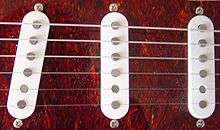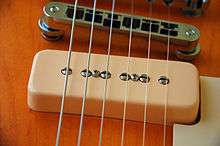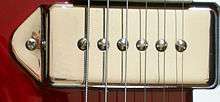Single coil guitar pickup


A single coil pickup is a type of magnetic transducer, or pickup, for the electric guitar and the electric bass. It electromagnetically converts the vibration of the strings to an electric signal. Single coil pickups are one of the two most popular designs, along with dual-coil or "humbucking" pickups.
History
Beauchamp

In the mid-1920s George Beauchamp, a Los Angeles, California guitarist, began experimentation with electric amplification of the guitar. Originally using a phonograph pickup assembly, Beauchamp began testing many different combinations of coils and magnets hoping to create the first electromagnetic guitar pickup. He wound his earliest coils using a motor out of a washing machine, later on switching to a sewing machine motor, and eventually using single coiled magnets.
Beauchamp was backed in his efforts by Adolph Rickenbacker, an engineer and wealthy owner of a successful tool and die business. Beauchamp eventually produced the first successful single coil pickup. The pickup consisted of two massive "U" shaped magnets and one coil and was known as the "horseshoe pickup". The two horseshoe-shaped magnets surrounded the strings that passed over a single core plate (or blade) in the center of the coil.
Gibson
The Gibson Guitar Corporation introduced the "bar pickup" in 1935 for its new line of Hawaiian lap steel guitars. The pickup's basic construction is that of a metal blade inserted through the coil as a shared pole piece for all the strings. A pair of large flat magnets were fastened below the coil assembly.
In 1936 Gibson introduced the ES-150, its first electric Spanish styled guitar. The ES-150 was outfitted with the bar pickup. Jazz guitar innovator, Charlie Christian, began playing an ES-150 in the late 1930s with the Benny Goodman Orchestra. This caused the popularity of the electrified guitar to soar. Due to Christian’s close association with the ES-150 it began being referred to as the “Charlie Christian Model” and Gibson’s now famous bar pickup as the “Charlie Christian pickup” or “CC unit”.
Common designs
Gibson P-90
The P-90 is a single-coil pickup designed by the Gibson Guitar Corporation. These pickups have a large, flat coil with adjustable steel screws as pole pieces, and a pair of flat alnico bar magnets lying under the coil bobbin. The adjustable pole pieces pick up the magnetism from the magnets. Moving the screw closer or further away from the magnet determines signal strength, thus tone as well. There are two variations of P-90 pickup that differ mainly by mounting options:

- Soap bar casing has true rectangular shape and the mounting screws are contained within the coil perimeter, positioned between the pole pieces, between strings 2-3 and 4-5, thus creating irregular and somewhat unusual pattern. Occasionally, they are mistaken for pole pieces; thus, the P-90 is sometimes erroneously said to have eight pole pieces. The "soap bar" nickname most probably comes from its predominantly rectangular shape and proportions resembling a bar of soap, and the fact that the first P-90s on the original Gibson Les Paul Model of 1952 were white.

- Dog ear is a casing type with extensions at both sides of pickup that somewhat resemble dog's ears. These are extensions of the predominantly rectangular cover that encompass the outlying mounting screws. Dog-ear P-90 pickups were commonly mounted on Gibson's hollowbody guitars like the ES-330 and occasionally on solid body models like the Les Paul Junior. The same pickups were also available on Epiphone models (since Gibson was building Epiphone guitars in the 1950s) and the design is best remembered for its appearance on the hollow body Epiphone Casino of the mid to late 1960s.
The sound of a P-90 is somewhat brighter and more transparent than Gibson's later humbucker pickup, and every bit as crisp and snappy as Fender's single-coil pickups despite its high output and big sound.
Despite its tonal qualities the P-90 fell out of favor with Gibson in the early 1950s as a consequence of guitar players complaining about the amount of hum (noise) it put out. Gibson employee Seth Lover solved the hum problem by designing a hum-canceling pickup known as a humbucker, it was supposed to sound like a P-90 but in fact has quite a different sound. It nevertheless became Gibson's mainstay pickup from that point on. The P-90 likely did not become as popular for that reason, although many guitarists still prefer the tone of the P-90.
Telecaster design

The Fender Telecaster features two single coils. The neck pickup produces a mellower sound, while the bridge pickup produces an extremely twangy, sharp tone with exaggerated treble response, because the bridge pickup is mounted on a steel plate. These design elements allow musicians to emulate steel guitar sounds, making it particularly appropriate for country music.
Pickups are selected with a three-position switch, and two wiring schemes exist:
- Vintage: 1) neck pickup with treble cutoff for a bassier sound; 2) neck pickup only; 3) bridge pickup only.
- Modern: 1) neck pickup only, with no treble cutoff; 2) neck and bridge; 3) bridge pickup only.
The Fender Esquire has a variation to the Vintage wiring scheme by using the scheme on a single pickup. This gives a treble cutoff in the first position, normal in the middle position, and a tone control cutoff in the third position.
Stratocaster design

The traditional Stratocaster design guitar features three single coils. The guitarist can control which pickup or combination of pickups are selected with a lever switch. The pickup positions are usually referred to as the bridge, middle and neck pickups based on their proximity to those parts of the instrument.
Modern Stratocasters have five-position pickup selector switch. Positions 1, 3 and 5 activate only one pickup (bridge, middle or neck respectively), while positions 2 and 4 activate a combination of two pickups (bridge and middle, or middle and neck, respectively). Some pickup sets have a reverse wound and reverse polarity middle pickup that when in combination with the normal bridge or neck pickups will cancel electromagnetic interference (noise/hum) which single coil pickups suffer badly from. The sonic effect of positions 2 and 4 is sometimes referred to as a "quack" or "notch positions", and some guitar notation includes directions to use these pickup combinations. One example is "Sultans of Swing" by Dire Straits which is played in position 2 (bridge and middle).
Noise problems
Two types of noise afflict magnetic guitar pickups. Hum is caused by magnetic fields due to power frequency currents in electrical equipment, whereas buzz is propagated as radio transmissions and sounds more like static. The sources of buzz are many, but one example is an AC power tool with a brush motor. The Brush (electric) makes and breaks electrical contact with the commutator segment several thousand times a second at variable frequency dependent on load thus causing radio frequency noise.
Kinman Guitar Electrix were awarded 5 or more US patents beginning circa 1996 for innovative design concerned with hum canceling single pole pickups. Kinman at first concentrated on particularly the Fender type single coil pickup and in 2009 the P-90 pickup. One of the most important elements of Kinman's patents is the use of iron in the core of the noise sensing coil. This was absolutely novel in 1996 and without the presence of iron to boost the efficiency of the noise sensing coil differential coil technology would not have been possible. Vertical differential coil technique is also described in Kinman's US Patents 5,668,520 and 6,103,966 with priority date of March 1996. After 1998 DiMarzio and Seymour Duncan also began using iron and differential winding techniques in the noise sensing coils in some of their products. Over the years Kinman has improved and refined their designs to a point where the popular consensus is the sound of some models is indistinguishable from noisy single coils. Kinman also manufactures noiseless P-90 and Telecaster pickups under US Patent 7,022,909
The search for an acceptable solution to mains hum gained new impetus around 1995 as guitar players became increasingly intolerant of degraded stacked single-coil sound. Fender was researching new techniques to solve the loss of tone around that time and eventually came out with their Vintage Noiseless design circa 1998.[1]
Notable single-coil pickups
There are several well-known single-coil pickups that have a distinctive sound:

- Rickenbacker pickups (including the original 1930s "horseshoe" pickup as used in lap steel and solidbody upright basses, and later 6 string electric guitars, pedal steels, and electric bass guitars; also the "Toaster" and "Hi-Gain")
- Gibson bar pickup (1935) — later called the Charlie Christian pickup (1938)
- Gibson P-90 (1946)
- Fender Telecaster, Stratocaster, Jazzmaster, Jaguar, and other pickups
- Danelectro Lipstick
- Gretsch pickups (including the "HiLoTron")
- DeArmond pickups (found on various 50s and 60s guitars by various manufacturers including Gretsch, Guild, Epiphone, Martin, Kustom, Harmony, Regal, Premier, Silvertone, and others, but produced by the Rowe - DeArmond company of Toledo, Ohio; the trade name is now owned by Fender; single coil models including the 200 aka Dynasonic,[2] 2K, and 2000, "mustache", various "gold foil" types, and many clip on, rail, or screw mount pickups designed for acoustic guitars and other instruments). The Fender "Tele-Sonic" featured large DeArmond single coils.
- Valco single coil pickups by Ralph Keller (1954) can be found in Airline, Supro, National, English Electronics, Custom Kraft, and a few Gretsch models of guitar from the 50's, 60's, and 70's. The majority of these pickups maintain the physical appearance of a larger, double coil humbucker pickup. Although consisting of a single coil, the pickup contains a second, off-set magnet which cancels hum. Early variations on the Valco made over-strings "horseshoe" pickup can be found on a number of similarly branded lapsteel guitars, such as Oahu.
- Epiphone "New York" pickups
- Lace Sensor pickups (1987)
See also
References
- Batey, Rick (2003). The American Blues Guitar. Hal Leonard. ISBN 0-634-02759-X.
- Duchossoir, A. R. (1998). Gibson Electrics: The Classic Years. Hal Leonard. ISBN 0-7935-9210-0.
- Millard, Andre (2004). The Electric Guitar: A History of an American Icon. Johns Hopkins University Press. ISBN 0-8018-7862-4.
- Hirst, Tom (2003). Electric Guitar Construction. Hal Leonard. ISBN 1-57424-125-7.
- Smith, Richard R. (1987). The History of Rickenbacker Guitars. Centerstream Publications. pp. 9–14. ISBN 0-931759-15-3.
- Fjestad, Zachary R. (2005). Blue Book of Electric Guitars. Blue Book Publications, Inc. p. 397. ISBN 1-886768-57-9.
- ↑ Steve Cobham (June 1997). "NECK AND NECK - Gibson Les Paul and Fender Strat Compared". Sound On Stage.
- ↑ "Dynasonics products". Retrieved 2014-03-05.
External links
- The (commercial) history of Gibson pickups
- Science and measurements behind electro-magnetic guitar pickups
- Kinman Guitar Electrix - Impersonator 54 noiseless Strat pickup